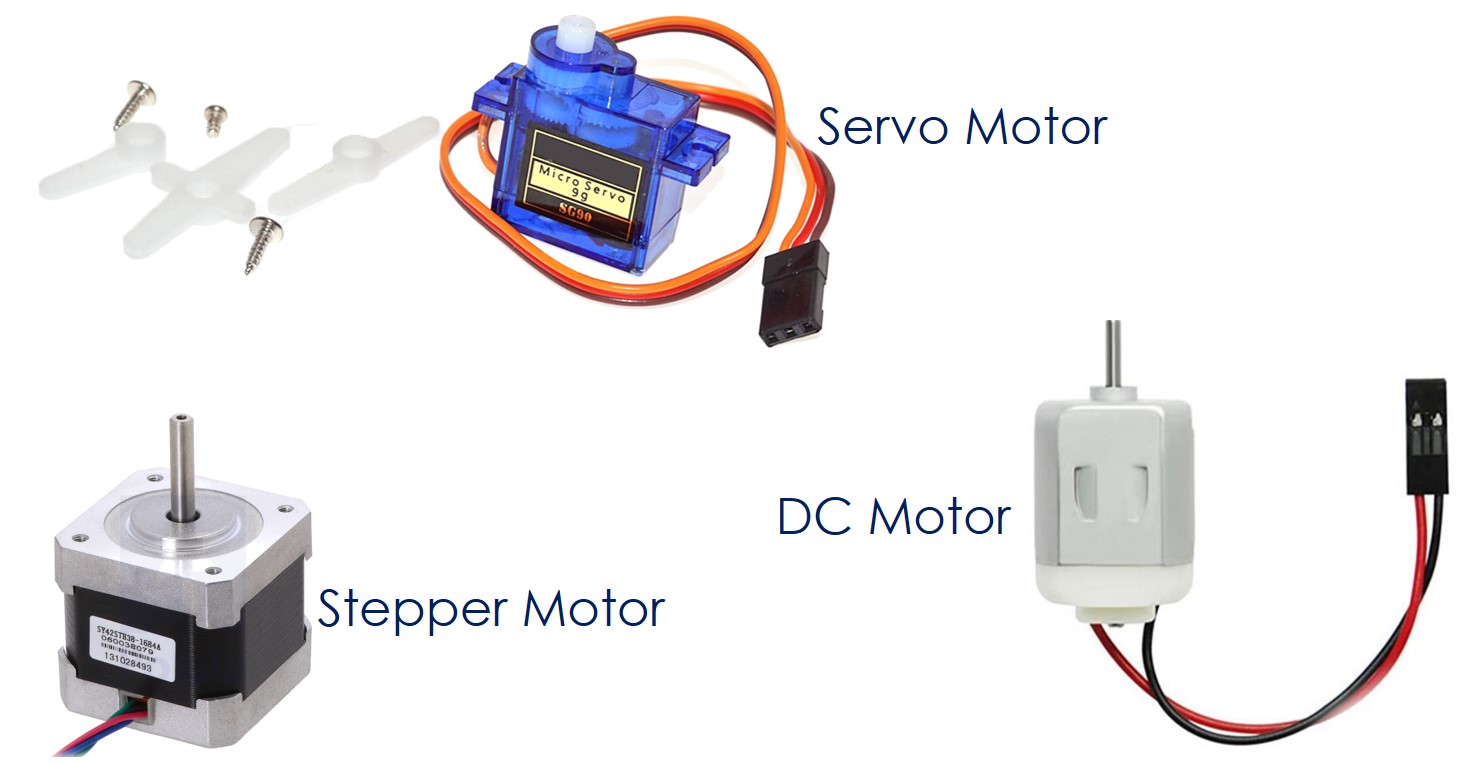Arduino Nano - Motor
This tutorial instructs you how to use Arduino Nano and ......... to control ........... . In detail:
- The types of motors that can be used with Arduino Nano
- The distinctions between the various types of motors
- How to manage each type of motor
Motor Types
There are three kinds of motors that are commonly used with Arduino:
- Servo motor
- Stepper motor
- DC motor

There are two primary varieties of servo motors: 180° servo motor and 360° servo motor. Generally, when people think of a servo motor, they are usually referring to the 180° servo motor.
A 360° servo motor is similar to a DC motor, but does not require a hardware driver.
180° Servo motor
Characteristics
- The range of rotation is from 0° to 180°.
- The direction of rotation can be either clockwise or counter-clockwise.
- It is possible to control the rotation to a specific angle between 0° and 180°.
- The speed of rotation is adjustable, but not in a smooth manner.
- No extra hardware driver is necessary for control, as it can be done directly from an Arduino Nano pin.
- An extra power supply is necessary.
- Controlling the rotation is easy, as it can be done with a PWM signal.
Application
- Any application that necessitates only a rotation of an angle between 0° and 180°.
Servo motor Tutorial
Visit this page for a tutorial on Arduino Nano and Servo Motor.
Stepper motor
Characteristics
- The amount of rotation is not restricted.
- The direction of rotation can be either clockwise or counter-clockwise.
- The position of rotation can be precisely adjusted to any angle.
- The speed of rotation can be accurately controlled, as well as the acceleration and deceleration.
- Additional hardware and power supply are required.
- Controlling it is complex, so beginners should use a library.
Application
- Automation and robotics
- Printers, 3D printers, CNCs, X-Y plotters
- Cocktail Machines
Stepper Motor Tutorial
Check out this tutorial on Arduino Nano and Stepper Motors: Arduino Nano - Stepper Motor tutorial. Explore the tutorial on Arduino Nano and Stepper Motors: Arduino Nano - Stepper Motor tutorial
Link: Arduino Nano - Stepper Motor with L298N driver tutorial. A tutorial on how to use Arduino Nano to control a stepper motor with an L298N driver can be found here: . Arduino Nano - Stepper Motor with L298N driver tutorial. This link provides a tutorial for controlling a stepper motor with an Arduino Nano and an L298N driver: . Arduino Nano - Stepper Motor with L298N driver tutorial. For instructions on using Arduino Nano to control a stepper motor with an L298N driver, please refer to the following tutorial: . Arduino Nano - Stepper Motor with L298N driver tutorial. If you are looking for guidance on how to use Arduino Nano to control a stepper motor with an L298N driver, check out this tutorial: . Arduino Nano - Stepper Motor with L298N driver tutorial
Arduino Nano Tutorial: Controlling a 28BYJ-48 Stepper Motor using the ULN2003 Driver. A guide on how to use an Arduino Nano to control a 28BYJ-48 Stepper Motor with the ULN2003 Driver.
DC motor
Characteristics
- The number of rotations is not limited.
- The direction of rotation can be either clockwise or counter-clockwise.
- It is very hard to rotate to a precise angle.
- It is easy to control the speed of rotation, but it is difficult to set a specific speed value.
- An extra hardware driver is necessary.
- An additional power supply is also required.
- Controlling the rotation is simple, just use a high-voltage PWM signal.
※ NOTE THAT:
- , which makes the control easier.
- To achieve precise positioning of a DC motor, extra hardware is required, such as an encoder, and a closed-loop control method, like PID control, must be used. This can be challenging for beginners.
- For speed control, it is easy to adjust the speed, such as slow, medium, fast, or very fast, as well as the percentage of full speed. However, to control the number of rotations per second, an encoder and a closed-loop control method like PID control are needed. This can be difficult for those just starting out.
- Certain DC motors on the market come with a built-in encoder, making the control process simpler.
Application
- Previously used to manage something that requires steady rotation, without the need to specify the speed. Examples include fans, pumps, RC cars, drills, etc.
※ NOTE THAT:
and robotics. There are two primary types of DC motors: brushed and brushless. Brushed DC motors are commonly used in DIY projects and robotics.
DC motor Tutorial
Check out our Arduino Nano - DC Motor tutorial for more information!. Take a look at our Arduino Nano - DC Motor tutorial for further details!
Motor selection guide
When selecting a motor for a project, there are various factors to consider, such as the weight it must carry, the power supply, and the characteristics of the application:
- If your project requires a rotation between 0° and 180°, then you should look for a 180° servo motor
- If your project needs to rotate accurately to any position, then you should find a stepper motor
- If your project needs to rotate continuously without any specific position, then you should acquire a DC motor or a 360° servo motor
Buy Motor
Additionally, some of these links are for products from our own brand, DIYables .
